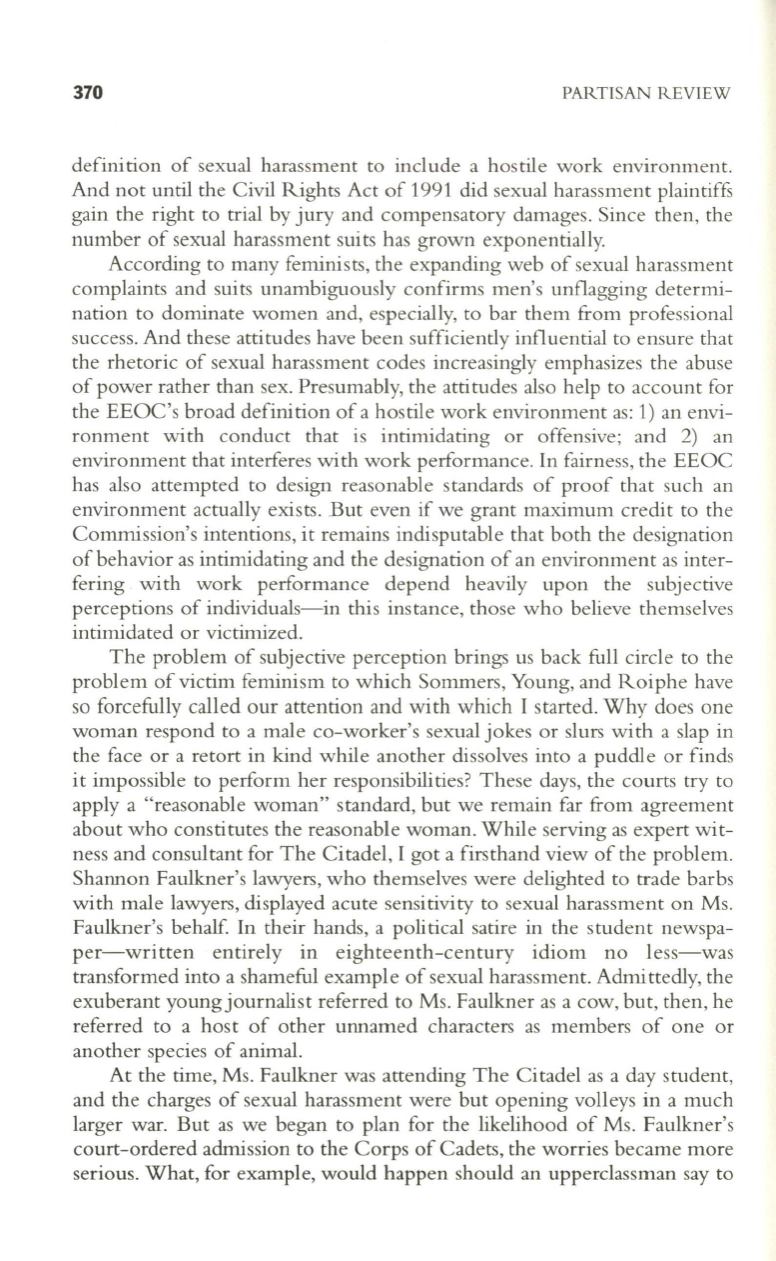
370
PARTISAN R.EVIEW
definition of sexual harassment to include a hostile work environment.
And not until the Civil Rights Act of 1991 did sexual harassment plaintiffs
gain the right to trial by jury and compensatory damages. Since then, the
number of sexual harassment suits has grown exponentially.
According to many feminists, the expanding web of sexual harassment
complaints and suits unambiguously confirms men's unflagging determi–
nation to dominate women and, especially, to bar them from professional
success. And these attitudes have been sufficiently influential to ensure that
the rhetoric of sexual harassment codes increasingly emphasizes the abuse
of power rather than sex. Presumably, the attitudes also help to account for
the EEOC's broad definition of a hostile work environment as: 1) an envi–
ronment with conduct that is intimidating or offensive; and 2) an
environment that interferes with work performance. In fairness, the EEOC
has also attempted to design reasonable standards of proof that such an
environment actually exists. But even if we grant maximum credit to the
Commission's intentions, it remains indisputable that both the designation
of behavior as intimidating and the designation of an environment as inter–
fering with work performance depend heavily upon the subjective
perceptions of individuals-in this instance, those who believe themselves
intimidated or victimized.
The problem of subjective perception brings us back full circle to the
problem of victim feminism to which Sommers, Young, and Roi phe have
so forcefully called our attention and with which I started. Why does one
woman respond to a male co-worker's sexual jokes or slurs with a slap in
the face or a retort in kind while another dissolves into a puddle or finds
it impossible to perform her responsibilities? These days, the courts try to
apply a "reasonable woman" standard, but we remain far from agreement
about who constitutes the reasonable woman. While serving as expert wit–
ness and consultant for The Citadel, I got a firsthand view of the problem.
Shannon Faulkner's lawyers, who themselves were delighted to trade barbs
with male lawyers, displayed acute sensitivity to sexual harassment on Ms.
Faulkner's behalf.
In
their hands, a political satire in the student newspa–
per-written entirely in eighteenth-century idiom no less-was
transformed into a shameful example of sexual harassment. Admi ttedly, the
exuberant young journalist referred to Ms. Faulkner as a cow, but, then, he
referred to a host of other unnamed characters as members of one or
another species of animal.
At the time, Ms. Faulkner was attending The Citadel as a day student,
and the charges of sexual harassment were but opening volleys in a much
larger war. But as we began to plan for the likelihood of Ms. Faulkner's
court-ordered admission to the Corps of Cadets, the worries became more
serious. What, for example, would happen should an upperclassman say to


